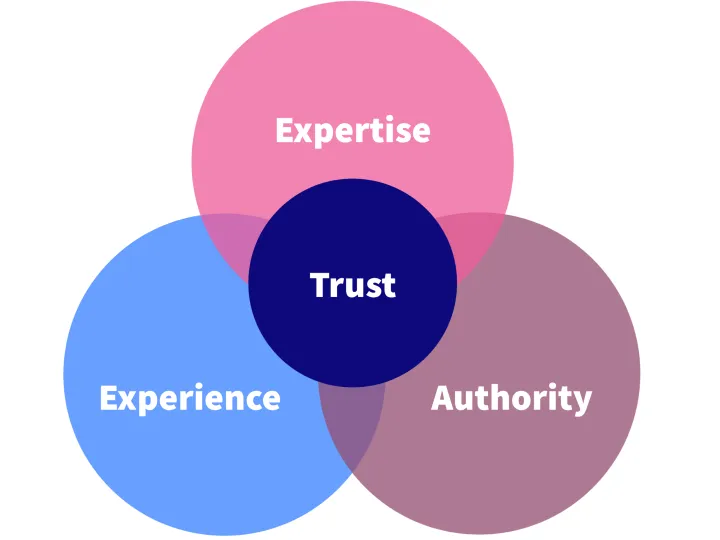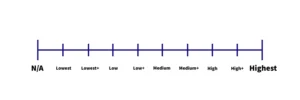E-E-A-T: a complete guide
In this article, we explain the four E-E-A-T pillars anno 2025. We give specific examples and show how you can improve your website's E-E-A-T. Care to know more?
Expertise SEO
By Amy Hoogendoorn


From E-A-T to E-E-A-T
E-E-A-T or double-E-A-T are the four pillars in the algorithm that Google uses to show users the most relevant search results and reliable information. E-A-T has been a principle in the online marketing world for some time, and Google added it to its Search Quality Guidelines in 2014. In December 2022, Google revised these Guidelines and made some significant changes.
The guide, which explains how Google determines the quality of websites, has been expanded with additional examples and relevant information to help you rank better. This is where the new “E” in E-A-T comes in. The way we interpret these changes, means that the reliability and quality of content will continue to become more important and will have a significant impact on SERP rankings. That is why we would like to explain it to you, including examples and a checklist. Ready?

What does the principle entail?
Google uses the E-E-A-T principle to assess whether a website provides users with relevant, high-quality and reliable content. This enables Google to show searchers the right search results, thereby fulfilling the user’s goal. E-E-A-T stands for:
- Expertise
- Experience
- Authoritativeness
- Trustworthiness
What each of those mean, exactly? View our summary below.
E-E-A-T, summarized
Expertise
Expertise means that the content has been written by an expert who has extensive knowledge of the subject matter. When text is written by an expert, it ensures that the content comes across as reliable. Think of a blog page about the latest fashion trends, written by an employee of a clothing store or a fashion designer.
Experience
Experience is fairly self-explanatory: the content is written by an author who has some form of experience and affinity with the product or service. Think, for example, of a restaurant review written by someone who has actually visited the restaurant. This makes the review extra reliable and therefore more relevant to a searching user.
Authoritativeness
Authoritativeness means that a website is an authority within a field, which is achieved by receiving external backlinks. Google sees references from other relevant sites to your page as an important signal that your page is valuable. Think, for example, of a backlink from a news article or relevant website, where your blog page is used as a source to share relevant information.
Trustworthiness
Trustworthiness is the most important aspect of E-E-A-T. Experience, expertise and authoritativeness support the reliability of a website. If a website is unreliable, it will automatically receive a low E-E-A-T score and therefore lower positions in the search results, regardless of how expert, experienced or authoritative it is. A reliable website, in combination with the other three pillars, will therefore have the desired effect on the rankings.

The difference between expertise and experience
The line between expertise and experience is quite thin, as someone with knowledge about a product or service often also has experience with it. Yet there is a difference. Expertise refers to objective knowledge or skills that are verifiable and accurate. Experience is often subjective and refers to people’s opinions. This is often shared through a personal story or experience.
Is E-E-A-T a rankingfactor?
The pillars above are not direct ranking factors. However, they do have an indirect influence on a website’s performance. If you meet these pillars, Google will consider your website valuable and you will be displayed more quickly in the search results. Of course, the quality of content has been important for years in order to perform well in the SERP, this is nothing new. With the E-E-A-T principle, though, high-quality content can be assessed even better.
How does Google assess these pillars?
Google assesses the quality of a page (PQ rating) based on the following scale:

This takes into account the purpose of a website or page. If a page is misleading or could cause harm, it will be given the lowest possible PQ rating. Google therefore looks at how a page achieves its purpose to determine whether it is user-friendly.
The most important factor that has the greatest influence on page quality is the “Main Content”. Google sees this as the content on the page that directly influences the communication of the purpose of that specific page. By “Main Content” we mean, in addition to text: images, videos and audio (such as a podcast).
By writing good, clear and original content that has taken time and effort to produce, you can better communicate your expertise and Google will give your page a higher rating on the previously mentioned scale.
E-E-A-T and AI
Nowadays though, content has a new key player with a major impact on the online content landscape: AI. ChatGPT and other language models can roll out texts at record speed, and today there are few people who do not use them. However, AI models are not copywriters, but generative prediction models. What that means? They generate their texts based on all the content that can already be found on the internet, and the output is a prediction of what you, as a user, are likely to want to see. This has several consequences for the content produced:
- The content is not unique, because it is based on all the content that can be found somewhere on the internet.
- The output lacks real experience and tangible examples that demonstrate expertise.
- They also lack human nuance, for example in persuasiveness, wordplay, and other things that make a text appealing.
- Moreover, the texts often remain superficial and lack real depth.
Logically, this has consequences for the unique value and usefulness of a text for a user, which is an important factor for Google in determining whether a page will rank high in search results or not. Google itself writes extensively about the use of AI in content, stating the following: “When it comes to automatically generated content, our guidance has been consistent for years. Using automation—including AI—to generate content with the primary purpose of manipulating ranking in search results is a violation of our spam policies” (source).
Does this mean that AI is completely useless when it comes to complying with the E-E-A-T principle? Certainly not.
What does Google say?
In fact, AI can definitely contribute to the creation of high-quality content, provided it is used correctly. In the same article, Google also states: “Appropriate use of AI or automation is not against our guidelines. (…) Our focus on the quality of content, rather than how content is produced, is a useful guide that has helped us deliver reliable, high-quality results to users for years.” (source). In short: Google does not penalise the use of AI. In fact, it encourages the creation of high-quality content, regardless of the tools used to produce it. As long as the E-E-A-T principle is met, it does not matter whether AI is used or not. Would you like to comply with the E-E-A-T principle and do you use AI? Then keep the following points in mind:
- Always check the information provided by AI, for example by asking for sources. If necessary, use a source reference on the website itself.
- Always supplement the content yourself, for example with your own experience and elements such as tables and images.
- Make the content concrete: AI tends to be superficial, so supplement it with concrete examples and explanations.
- Good prompts: experiment with prompts and use clear instructions to get the most out of AI.
How can you comply with the E-E-A-T guidelines?
There are various items, pages, or elements you can add to optimise your content for these guidelines. Here are a few possibilities!
'About us'-page
When assessing page quality, Google also takes into account what a website or the author of an article says about themselves. This can be communicated via an “About us” page. To make this as complete as possible, Google indicates that the page should discuss the history of a company, who the founders are, and what kind of service and quality they offer. This can be used to determine whether the author or owner of a website is a reliable source.
The quality of content
The quality of content is important for conveying the purpose of a page. Google looks at the level of effort, originality, talent and accuracy of content. By actively investing time and effort in writing a text or creating a video or podcast, Google will consider your content to be original and unique. Accuracy is particularly important for informative pages, where it is relevant that the content is factually correct.
Images, tables and bullet points
A good way to show that effort and originality have been put into a blog is to use original images, tables and lists. This also makes a text more readable, which indirectly affects the user-friendliness of a page. It also allows you to better convey your knowledge and expertise. When using images, it is important that they are original.
Author and source citation
Mentioning the author of an article or blog page is a useful way to convey expertise and reliability. This allows you to clearly communicate the author's level of knowledge to visitors. Source references also confirm to search engines that the information in a blog or article has been researched and is based on facts. This contributes to reliability and reinforces your expertise.


Communicating trust as a webshop
As a webshop, it is very important that visitors trust your website. According to the Search Quality Guidelines, you can incorporate the following aspects into your website to convey reliability:
- Reliable payment methods: as a user, you want to be sure that you can make a secure payment at a webshop. Google thinks the same way. By clearly communicating your payment methods on the website, you come across as more reliable.
- Contact page and easily accessible customer service: a contact page makes it easier for users to get in touch. It is also essential that a webshop has easily accessible customer service so that users can ask questions immediately.
- Information about shipping and returns: this information is also relevant to users and therefore important to mention on the website.
- Reviews at company and product level: reviews influence the reputation of a website. Reviews are based on the experience users have with a webshop and products. Product reviews help other users make an informed choice when making a purchase. They therefore give a good impression of the reliability of a website.
Checklist for E-E-A-T optimalisation
The checklist below summarises the E-E-A-T story. You can use this checklist to check whether there are still opportunities for further SEO optimisation within your website, so that your website is E-E-A-T-worthy.
A clear “About Us” page with information about your company and employees.
Clearly communicate reviews, both at company and product level, on your website.
Make sure visitors can easily get in touch. Also, clearly communicate information about shipping and returns.
Communicate the payment methods you use as a webshop on your website.
Make content original and accurate by putting time and effort into it, allowing your talent/experience/expertise to shine through.
Make your content factually reliable by including source references in the text.
Make your expertise clear by naming the author of the blog and providing any relevant background information.
Use original images, tables, bullet points, and listings, to make your content readable and to convey originality.
Need help with E-E-A-T or any other website optimisation matter?
Aspen Digital’s SEO-specialists would love to help you. Get in touch to get your website to the top of Google!
